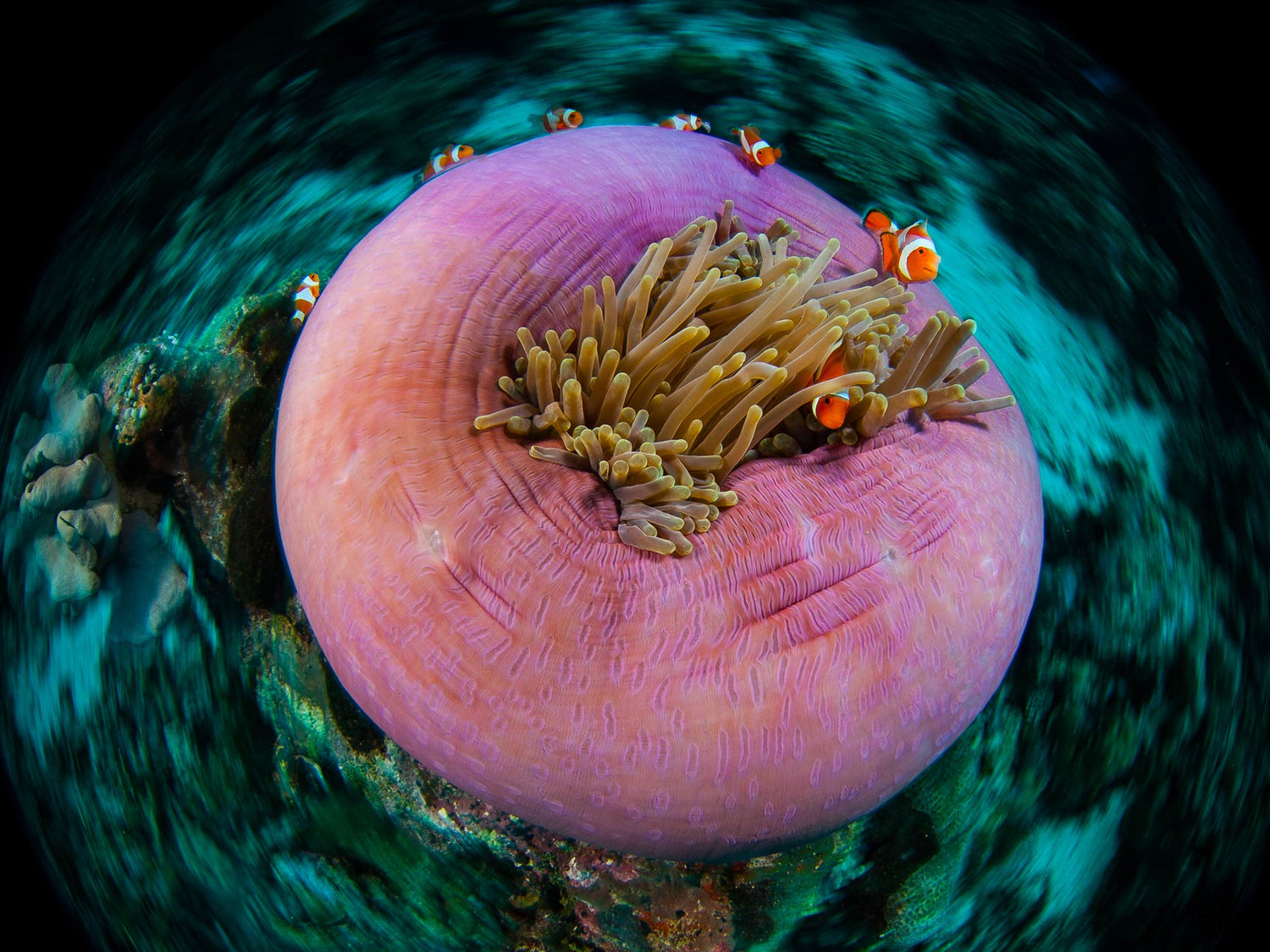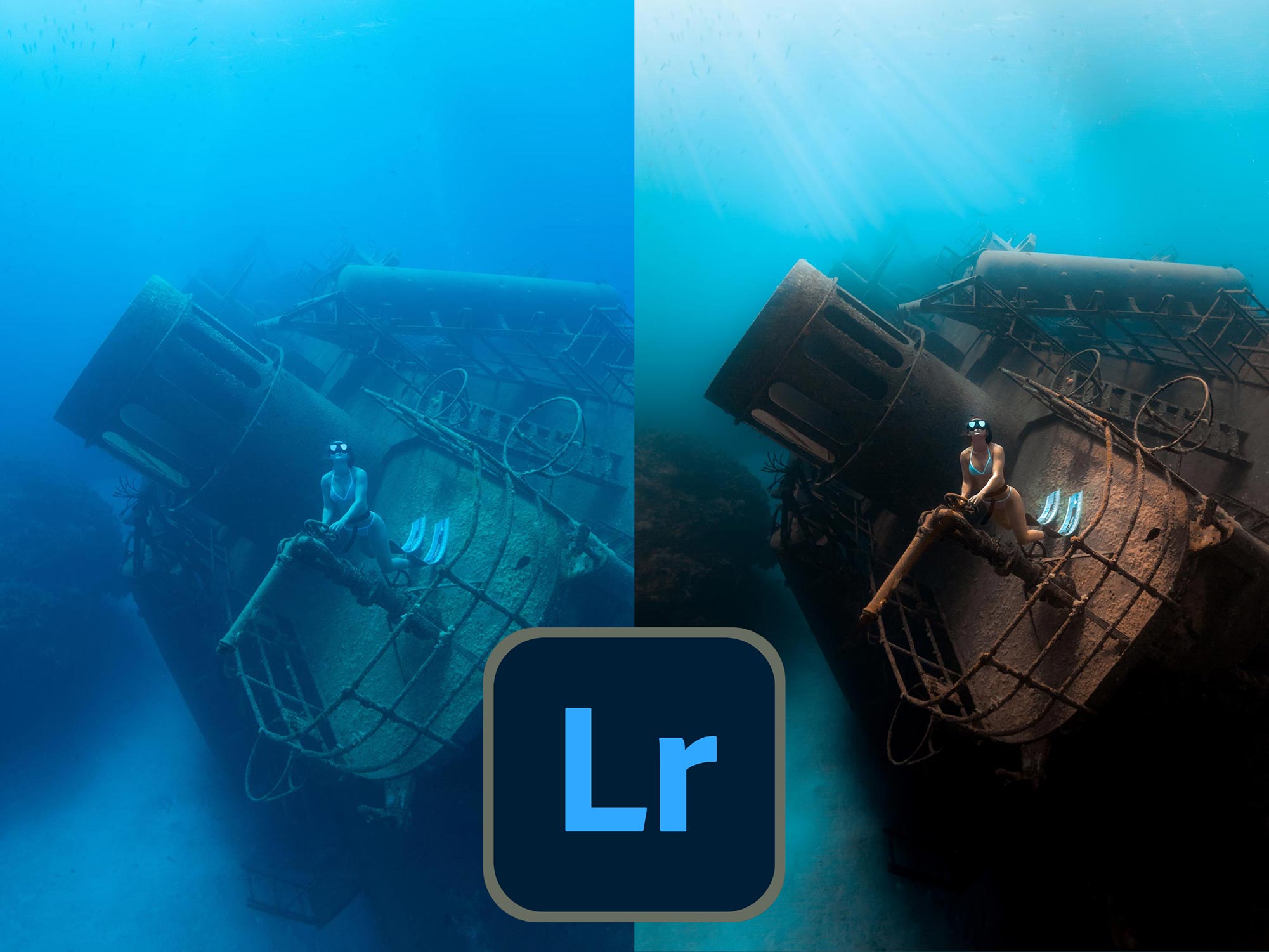By Steve Miller
"Dynamic duo" might be the most apt term for anemone and their clownfish counterpart. Bulbous and tentacled, anemones are often home to the active and animated clownfish. Besides the photogenic nature of this synonymous pair, anemone and clownfish share a colorful history making them just as fun to learn about as they are to photograph. So sync up your strobes and let's do a deep dive on the anemonefish circus.

Much like a circus, clownfish movement among the anemone is fast-paced but if you're patient you will eventually see a movement pattern that you can use to your advantage while shooting. f/18 • 1/160 • ISO 100 © 2022 Steve Miller
Where | Joining the Circus
There are some things that you just can't find on even the most beautiful reefs of the Caribbean. If shooting big sea anemones and their resident clownfish is on your bucket list of subjects the South Pacific and Western Pacific is a great place to start - my favorites for this are Yap and Wakatobi, but Fiji, Philippines, the warm waters of the Indian Ocean and Great Barrier Reef are also home to these stunning creatures. I have even seen big anemones sold as food in open air markets in Indonesia. All of the images in this collection were shot on the reefs of Wakatobi in the Coral Triangle - this large, and roughly triangular area in the Western Pacific Ocean is widely known for its biodiversity and rich marine life. It is home to more than 500 distinct species of reef-building coral and thousands of species of fish.
Finding one of these giant beauties is a thrill, and most are found at sport diving depths (any depth less than 130 feet or 39.6 meters) but sometimes can be quite shallow. If you are lucky enough to find one perched on a sheer wall - allowing you to easily get close without touching the bottom - you may just want to spend the rest of your dive right there. The anemones themselves are beautiful, but a closer look will reveal clownfish, shrimp, and crabs, all sharing different parts of the anemone - a mini-habitat ripe for photo opportunities.

This frame took roughly 20 minutes to make. A super wide lens will present a totally different composition with very small changes in the tilt of the camera. Sometimes it pays to swim away and study the images you just shot, asking yourself what should be changed to make it a better frame. f/29 • 1/125 • ISO 100 © 2022 Steve Miller
How | Lighting and Lenses
Strobes are key to capturing the bold colors of anemones and their clownfish tenants. In the case of anemones, they are capable of a broad range of hues, most of us have no idea what color it will be until we light it up with flash. Bright purple and red are always a favorite. Some species of clownfish, like the spine-cheeked clownfish, are dark red and absorb the light from your strobe more than any other species I've found. TTL will compensate for this automatically but if you are shooting from a distance, on Manual, or are using a single strobe, you may need to open up the lens.

Lighting is a must in order to capture the rich hues of the anemone and clownfish. When shooting anemone we prefer strobes to video lights, since some lights will produce enough heat to affect the anemone. f/9 • 1/200 • ISO 100 © 2022 Steve Miller
The relationship between clownfish and anemones is fascinating, but the important thing for the photographer is that they are not going to swim away. Anemones can move, but slowly so it pays to simply observe for a few moments before shooting. The clownfish will dart around, peek out at you, then dart back into the tentacles. This can drive you crazy because it's the eye contact that you need to make the image strong. However, you may notice that the fish are actually following a similar route each time they dart away. Anticipating this, and waiting for them to look up at the lens, is your best bet. This one of those times where a strobe is a must, not just for color, but also to prevent motion blur.

This photo shows a clownfish and anemone lit with natural light and an (underpowered) video light. I have shot many clownfish images, but always with a DSLR stopped down far, and lots of flash. Editing these images was refreshing- a totally different look is produced by using natural light, and fill light from a video. We pick up grain, but there is a creamy texture that was fun to edit. f/3.2 • 1/400 • ISO 100 © 2022 Steve Miller
Most images you see of these subjects were probably shot with a macro lens- which is an obvious choice for small clownfish. Since anemones can be the size of a bowling ball, or a small beach ball - some can even grow to be nearly 6 feet (1.82m ) in diameter - the wide angle lens can be equally useful. The 8mm fisheye lens is usually associated with large subjects, but if you can get close enough it can make a beautiful scene.
Having a model hove in the distance can help your image too. With a super wide lens, the distance can be deceiving. A good model will look at their reflection in your dome and line themselves up with the sun for you. No matter what lens you're using, the beauty of an anemone is that you have plenty of time to study your image and perfect, or play, with your composition.

Thankfully, the anemones aren't going to swim away from you, leaving plenty of time to create a stunning image. Never underestimate the power of your dive buddy to help set the scene and display depth. f/10 • 1/125 • ISO 320 © 2022 Steve Miller
Why | The Symbiosis of Shapeshifters
It turns out that this is less a story of cohabitation and actually a story of mutual benefit. While the anemone provide clownfish a safe home and hunting ground, the clownfish attract unwitting animals toward the anemone providing the anemones with food. Clownfish also help protect the anemones from parasites that would otherwise harm them.
Although anemones may look like fodder for a Dr. Seuss book they're actually venomous carnivores equipped with stinging capsules called nematocysts. Having coevolved with anemones, clownfish have developed a protective layer of mucus that provides a barrier from an anemone sting. Other animals are not so lucky and this is used to the anemones advantage. The brightly colored clownfish lure unsuspecting animals to the anemone, resulting in a deadly sting and food for the anemone, the scraps of which are often feasted on by the clownfish too.
The familiar phrase "don't soil your own nest" might prove inaccurate for these two synonymous sea species. A 2008 study looked at the potential benefit of ammonia-rich clownfish feces as a fertilizer for anemone, showing that the clownfish waste was indeed a nutrient additive that aids anemones growth.
Much like the beneficial bacteria we find in the human gut, it appears that clownfish and anemone have evolved overtime to both protect and proliferate one another. Not to mention provide a picture perfect scene for underwater photographers.

While not every type of anemone and clownfish are compatible, the ones that are are considered obligatory symbionts wherein both species are often critically dependent on one another. f/20 • 1/160 • ISO 160 © 2022 Steve Miller
This has been studied extensively, including older studies where researchers wiped the mucus layer from clownfish, and fed them to the anemone by pushing them in. But when wiped and left to their own devices the clownfish would dip in and out of the tentacles and eventually be able to settle back in seemingly without being stung.
Tips of anemone tentacles have also been found in the stomachs of dissected clownfish, so some theorize that the anemone recognizes itself in the slime layer of the fish. In the 1970’s there was a study where resident clowns were captured and taken over a mile away and released. Somehow, these Nemo’s found their way home to their specific anemone companion.

A macro lens will capture the fine details of a clownfish, focusing on the eye is key to setting your image apart from the rest. f/16 • 1/125 • ISO 200 © 2022 Steve Miller
In addition to the fascinating relationship anemone and clownfish share, among their own species, clownfish also exhibit their own unique behaviors - namely sequential hermaphroditism. This is a reproductive strategy found mostly in coral reef-based fish wherein an animal begins life as one sex and changes to another.
At birth all clownfish are born male but upon the death of the female of the group the sequential hermaphroditism will occur. A guide at Wakatobi once described clownfish “families” as being more like an evil queen ruling the nest. She will be larger than the males and nip at them preventing a sex change. When she dies, one of the more dominate males will change from male to female and become the next "Evil Queen."

The spine-cheeked anemonefish is a very dark red. I have learned the hard way to open up the lens a stop or two for these guys. f/11 • 1/125 • ISO 160 © 2022 Steve Miller
Anemones are shape shifters in their own right too. We typically picture them as colorful and tentacled however they go through periods of inflation with water obscuring almost all of the tentacles. This doesn't follow a solar clock like flowers, but rather is part of their digestion process. Interestingly, anemone also prove somewhat resilient in the face of environmental changes. While they're subject to the same destructive bleaching as coral, they have a unique ability to maintain production of their venom despite environmental circumstances.

Partially closed, there are still enough tentacles to shelter the clownfish on this anemone. f/10 • 1/160 • ISO 160 © 2022 Steve Miller
Keep Your Friends Close, Keep Your Anemones Closer
Finding an anemone on your dive is a thrill. There are so many ways to capture interesting images, and often a lot of time to play with composition. Whether you love the alien like shapes of the anemone or the organized chaos of the clownfish, there's no shortage of color if you've got the right lighting. This dynamic duo provides a stationary yet spry scene for underwater photography and behavioral observation. The more you learn about these animals, the more interesting they become.
 Ambassador Steve Miller has been a passionate teacher of underwater photography since 1980. In addition to creating aspirational photos as an ambassador, he leads the Ikelite Photo School, conducts equipment testing, contributes content and photography, represents us at dive shows and events, provides one-on-one photo advice to customers, and participates in product research and development. Steve also works as a Guest Experience Manager for the Wakatobi Dive Resort in Indonesia. In his "free" time he busies himself tweaking his very own Backyard Underwater Photo Studio which he's built for testing equipment and techniques. Read more...
Ambassador Steve Miller has been a passionate teacher of underwater photography since 1980. In addition to creating aspirational photos as an ambassador, he leads the Ikelite Photo School, conducts equipment testing, contributes content and photography, represents us at dive shows and events, provides one-on-one photo advice to customers, and participates in product research and development. Steve also works as a Guest Experience Manager for the Wakatobi Dive Resort in Indonesia. In his "free" time he busies himself tweaking his very own Backyard Underwater Photo Studio which he's built for testing equipment and techniques. Read more...
Want the easy way to improve your underwater photography? Sign up for our weekly newsletter for articles and videos directly in your inbox every Friday:
Additional Reading
Clownfish Underwater Camera Settings
Anemone Underwater Camera Settings and Technique
Why You Need Strobes Underwater
The Myth of TTL Strobe Exposure Underwater
Divers on the Reef Underwater Camera Settings and Technique
Reflections: Manipulation with Mirrors and Light for Behavioral Images













